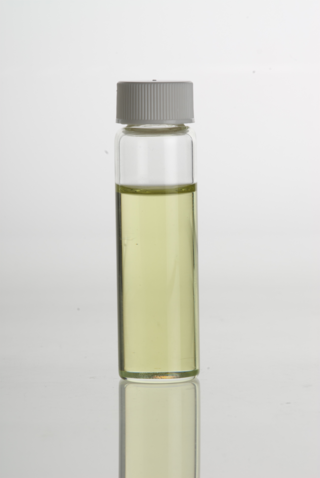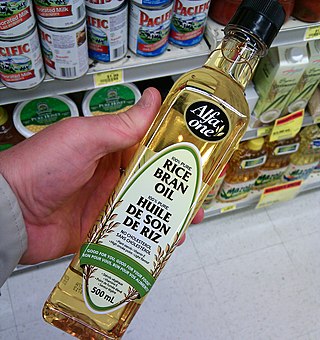
A carbohydrate is a biomolecule consisting of carbon (C), hydrogen (H) and oxygen (O) atoms, usually with a hydrogen–oxygen atom ratio of 2:1 and thus with the empirical formula Cm(H2O)n, which does not mean the H has covalent bonds with O. However, not all carbohydrates conform to this precise stoichiometric definition, nor are all chemicals that do conform to this definition automatically classified as carbohydrates.

Vitamins are organic molecules that are essential to an organism in small quantities for proper metabolic function. Essential nutrients cannot be synthesized in the organism in sufficient quantities for survival, and therefore must be obtained through the diet. For example, Vitamin C can be synthesized by some species but not by others; it is not considered a vitamin in the first instance but is in the second. Most vitamins are not single molecules, but groups of related molecules called vitamers. For example, there are eight vitamers of vitamin E: four tocopherols and four tocotrienols.
A nutrient is a substance used by an organism to survive, grow, and reproduce. The requirement for dietary nutrient intake applies to animals, plants, fungi, and protists. Nutrients can be incorporated into cells for metabolic purposes or excreted by cells to create non-cellular structures, such as hair, scales, feathers, or exoskeletons. Some nutrients can be metabolically converted to smaller molecules in the process of releasing energy, such as for carbohydrates, lipids, proteins, and fermentation products, leading to end-products of water and carbon dioxide. All organisms require water. Essential nutrients for animals are the energy sources, some of the amino acids that are combined to create proteins, a subset of fatty acids, vitamins and certain minerals. Plants require more diverse minerals absorbed through roots, plus carbon dioxide and oxygen absorbed through leaves. Fungi live on dead or living organic matter and meet nutrient needs from their host.
Food energy is chemical energy that animals derive from their food to sustain their metabolism, including their muscular activity.

In the context of nutrition, a mineral is a chemical element. Some "minerals" are essential for life, most are not. Minerals are one of the four groups of essential nutrients, the others of which are vitamins, essential fatty acids, and essential amino acids. The five major minerals in the human body are calcium, phosphorus, potassium, sodium, and magnesium. The remaining elements are called "trace elements". They are iron, chlorine, cobalt, copper, zinc, manganese, molybdenum, iodine, and selenium.
The Dietary Reference Intake (DRI) is a system of nutrition recommendations from the National Academy of Medicine (NAM) of the National Academies. It was introduced in 1997 in order to broaden the existing guidelines known as Recommended Dietary Allowances. The DRI values differ from those used in nutrition labeling on food and dietary supplement products in the U.S. and Canada, which uses Reference Daily Intakes (RDIs) and Daily Values (%DV) which were based on outdated RDAs from 1968 but were updated as of 2016.

Grape seed oil is a vegetable oil derived from the seeds of grapes. A by-product of the winemaking industry, it is typically used for edible applications.

Rice bran oil is the oil extracted from the hard outer brown layer of rice called bran. It is known for its high smoke point of 232 °C (450 °F) and mild flavor, making it suitable for high-temperature cooking methods such as stir frying and deep frying. It is popular as a cooking oil in East Asia, the Indian subcontinent, and Southeast Asia including India, Nepal, Bangladesh, Indonesia, Japan, Southern China and Malaysia.
Oxygen radical absorbance capacity (ORAC) was a method of measuring antioxidant capacities in biological samples in vitro. Because no physiological proof in vivo existed in support of the free-radical theory or that ORAC provided information relevant to biological antioxidant potential, it was withdrawn in 2012.

Sunflower oil is the non-volatile oil pressed from the seeds of the sunflower. Sunflower oil is commonly used in food as a frying oil, and in cosmetic formulations as an emollient.
Food fortification or enrichment is the process of adding micronutrients to food. It can be carried out by food manufacturers, or by governments as a public health policy which aims to reduce the number of people with dietary deficiencies within a population. The predominant diet within a region can lack particular nutrients due to the local soil or from inherent deficiencies within the staple foods; the addition of micronutrients to staples and condiments can prevent large-scale deficiency diseases in these cases.

Species belonging to the genus Amaranthus have been cultivated for their grains for 8,000 years. Amaranth plants are classified as pseudocereals that are grown for their edible starchy seeds, but they are not in the same botanical family as true cereals, such as wheat and rice. Amaranth species that are still used as a grain are Amaranthus caudatus L., Amaranthus cruentus L., and Amaranthus hypochondriacus L. The yield of grain amaranth is comparable to that of rice or maize.

Avocado oil is an edible oil extracted from the pulp of avocados, the fruit of Persea americana. It is used as an edible oil both raw and for cooking, where it is noted for its high smoke point. It is also used for lubrication and in cosmetics.

Elsie Widdowson, was a British dietitian and nutritionist. She and Dr Robert McCance, a pediatrician, physiologist, biochemist, and nutritionist, were responsible for overseeing the government-mandated addition of vitamins to food and wartime rationing in Britain during World War II.

Robert Alexander McCance, CBE, FRS was a British paediatrician, physiologist, biochemist and nutritionist and was the first Professor of Experimental Medicine at the University of Cambridge.
EuroFIR is a non-profit international association, which supports use of existing food composition data and future resources through cooperation and harmonization of data quality, functionality and global standards.
The USDA National Nutrient Database for Standard Reference is a database produced by the United States Department of Agriculture that provides the nutritional content of many generic and proprietary-branded foods. Released in August 2015 and revised in May 2016, the current release, Standard Reference 28 (SR28), contains "data on 8,800 food items and up to 150 food components". New releases occur about once per year. The database may be searched online, queried through a representational state transfer API, or downloaded.

A staple food, food staple, or simply staple, is a food that is eaten often and in such quantities that it constitutes a dominant portion of a standard diet for an individual or a population group, supplying a large fraction of energy needs and generally forming a significant proportion of the intake of other nutrients as well. For humans, a staple food of a specific society may be eaten as often as every day or every meal, and most people live on a diet based on just a small variety of food staples. Specific staples vary from place to place, but typically are inexpensive or readily available foods that supply one or more of the macronutrients and micronutrients needed for survival and health: carbohydrates, proteins, fats, minerals, and vitamins. Typical examples include grains, seeds, nuts and root vegetables. Among them, cereals, legumes and tubers account for about 90% of the world's food calorie intake.

In Indian cuisine, dal, paruppu or pappu, are dried, split pulses that do not require soaking before cooking. India is the largest producer of pulses in the world. The term is also used for various soups prepared from these pulses. These pulses are among the most important staple foods in South Asian countries, and form an important part of the cuisines of the Indian subcontinent.
Protein quality is the digestibility and quantity of essential amino acids for providing the proteins in correct ratios for human consumption. There are various methods that rank the quality of different types of protein, some of which are outdated and no longer in use, or not considered as useful as they once were thought to be. The Protein Digestibility Corrected Amino Acid Score (PDCAAS), which was recommended by the Food and Agriculture Organization of the United Nations (FAO), became the industry standard in 1993. FAO has recently recommended the newer Digestible Indispensable Amino Acid Score (DIAAS) to supersede PDCAAS. The dairy industry is in favor of this, because while PDCAAS truncates all protein types that exceed the essential amino acid (EAA) requirements to 1.0, DIAAS allows a higher than 1.0 ranking: while for example both soy protein isolate and whey isolate are ranked 1.0 according to PDCAAS, in the DIAAS system, whey has a higher score than soy.











